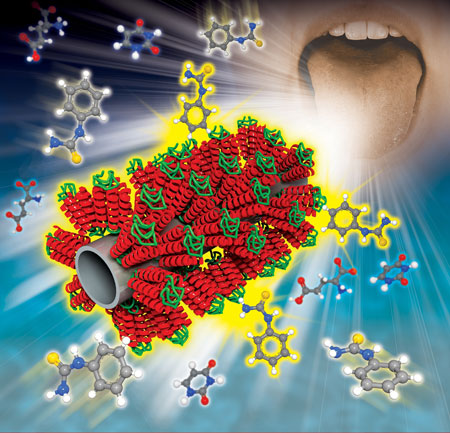| Posted: Dec 14, 2012 | |
Researchers develop a human-like nanobioelectronic tongue |
|
| (Nanowerk Spotlight) The concept of e-noses – electronic devices which mimic the olfactory systems of mammals and insects – is very intriguing to researchers involved in building better, cheaper and smaller sensor devices (read more: "Nanotechnology electronic noses"). Less well known is the fact that equivalent artificial sensors for taste – electronic tongues – are capable of recognizing dissolved substances (see for instance: "Electronic tongue identifies cava wines"). | |
| Conventional electronic tongues utilize pattern recognition for analysis using arrays of synthetic materials such as polymers, artificial membranes and semiconductors, for applications in the food and beverage industries. | |
| "Even with current technological advances, e-tongue approaches still cannot mimic the biological features of the human tongue with regard to identifying elusive analytes in complex mixtures, such as food and beverage products," Tai Hyun Park, a professor in the School of Chemical and Biological Engineering at Seoul National University, tells Nanowerk. | |
| Park, together with Professor Jyongsik Jang and their collaborators, have now developed a human bitter-taste receptor as a nanobioelectronic tongue. Reporting their work in a recent issue of Nano Letters ("Human Taste Receptor-Functionalized Field Effect Transistor as a Human-Like Nanobioelectronic Tongue"), they utilized a human taste receptor as a sensing element for mimicking the human taste system and selective detection. | |
 |
|
| A human tongue-like nanobioelectronic tongue. Illustration of the hTAS2R38-functionalized carboxylated polypyrrole nanotube. (Image: Dr. Park, Seoul National University) | |
| The nanobioelectronic tongue uses a human taste receptor as a recognition element and a conducting polymer nanotube field effect transistor (FET) sensor as a sensor platform. Specifically, the Korean team functionalized carboxylated polypyrrole nanotubes with the human bitter taste receptor protein hTAS2R38. They say that the fabricated device could detect target bitter tastants with a detection limit of 1 femtomole and high selectivity. | |
| In previous work, Park's research group already developed bioelectronic noses using human olfactory receptors. Since olfactory receptors and taste receptors have a similar structure, they could apply a similar approach for the development of nanobioelectronic tongue using human taste receptor protein. | |
| The result is a nanobioelectronic tongue that has high sensitivity and selectivity with human tongue-like properties. This device could find applications in the food or beverage industry for quality control and tastant screening. | |
| "In the case of bitter taste, our nanobioelectronic tongue can be used for sensing quantitatively the bitter taste, for example, of coffee, chocolate drinks, drugs and oriental medicines," says Park. "Our nanobioelectronic tongue can be used as an alternative to time-consuming and labor-intensive sensory evaluations and cell-based assays for the assessment of quality, tastant screening and basic research on the human taste system." | |
| There are five basic types of tastes including bitter, sweet, salty, sour and umami tastes. In order to mimic the real human tongue more closely, Park notes that the sensor should be a multiplexed array type containing all kinds of taste receptors. This will be the subject of future research. | |
 By
Michael
Berger
– Michael is author of three books by the Royal Society of Chemistry:
Nano-Society: Pushing the Boundaries of Technology,
Nanotechnology: The Future is Tiny, and
Nanoengineering: The Skills and Tools Making Technology Invisible
Copyright ©
Nanowerk LLC
By
Michael
Berger
– Michael is author of three books by the Royal Society of Chemistry:
Nano-Society: Pushing the Boundaries of Technology,
Nanotechnology: The Future is Tiny, and
Nanoengineering: The Skills and Tools Making Technology Invisible
Copyright ©
Nanowerk LLC
|
|
|
Become a Spotlight guest author! Join our large and growing group of guest contributors. Have you just published a scientific paper or have other exciting developments to share with the nanotechnology community? Here is how to publish on nanowerk.com. |
|
